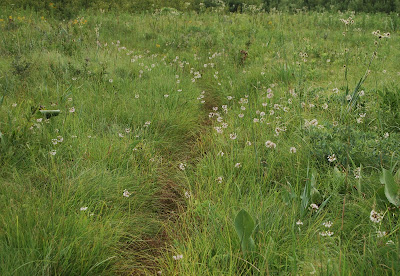The Show Garden at The Prairie Nursery
Of course it is the world's last and only preserved prairie landscapes that attracts, the Flint Hills of Kansas. There one can view large herds of bison and rolling prairies as far as the eye can see. But before we go deeper too much into the forthcoming trip, I'd like to tell you something from a visit to The Prairie Nursery in Westfield, Wisconsin, I visited last summer, the first week of August.
Neil Diboll shows me the difference between the species of Vernonia
The Prairie Nursery is run by Neil Diboll, a highly skilled grower and an internationally recognized pioneer in the use of native North American Prairie plants in gardens and landscapes. Neil is also a very talented and entertaining lecturer and I have earlier been privileged to listen to his lectures in both Alnarp in Sweden and Weinheim, Germany.
I have previously bought seeds from The Prairie Nursery to my landscaping projects in Alnarp, Laholm and Mariestad, and was therefore particularly interested in meeting Neil and his staff and to see how the nursery looked like.
Thousands upon thousands of small prairie plant seedlings in the greenhouse
After looking around in the office, we drove to the nursery where Neil first showed me the modern greenhouse, where nearly everything was controlled automatically, but the monitoring of the small, scrawny seedlings were handled manually of course.
Part of the model gardens at The Prairie Nursery in Westfield
At the nursery they have created several small model gardens with different themes. Here were, for example, a butterfly garden, a healing garden and a deer resistent garden. The prairie plants were planted in beautiful combinations in each garden plot and just at my visit, nearly all the plants appeared to be at their absolute peak development. It was clear that I had managed to hit on the right week for my stay, at least regarding the amazing flower display.
Agastache foeniculum, Monarda fistulosa and Ratibida pinnata
Liatris and Parthenium integrifolium
Neil Diboll and Peter Gaunitz outside the office. Photo: Sarie Doverspike



















































